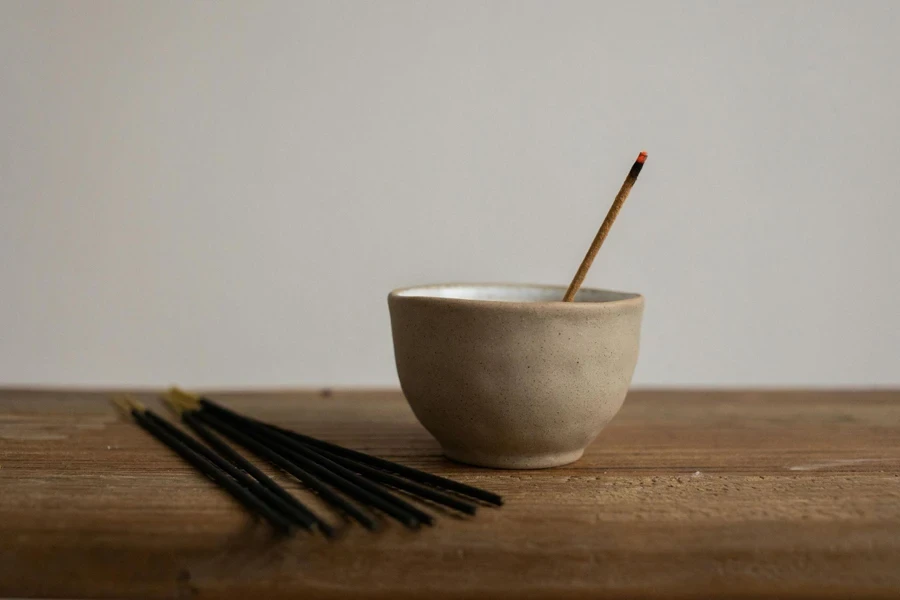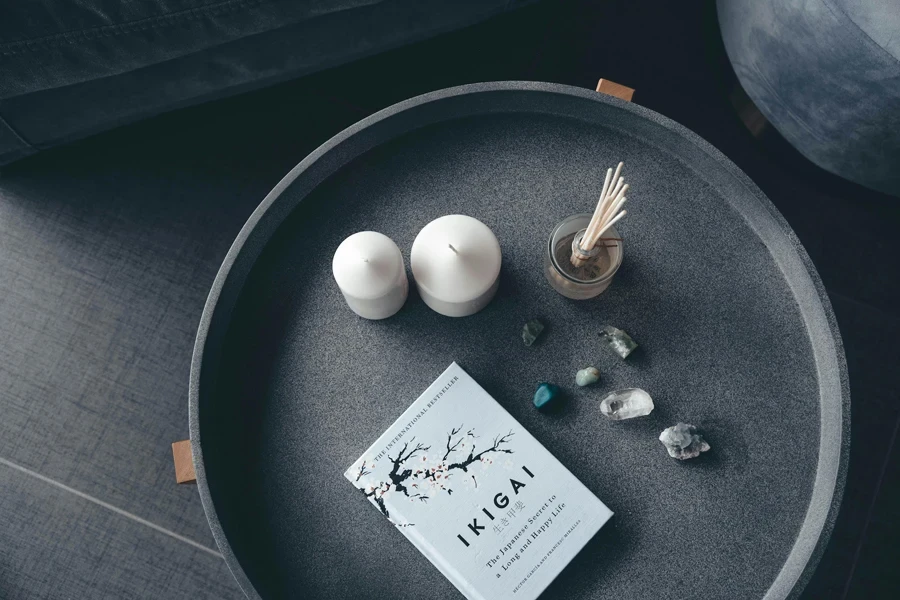Table of Contents
● Introduction
● Market overview
● Different types and their features
● Things to consider when selecting incense sticks and burners
● Conclusion
Introduction
Incense has woven its fragrance through history, being integral to spiritual practices, therapeutic environments, and homes. This ancient practice has transcended its origins in temples and shrines, permeating modern commercial spaces and wellness industries globally. Its significance is bolstered by the diversity of its forms and the depth of its cultural roots, driving its adoption across varied contexts—from yoga studios to retail atmospheres. The evolution of incense from a sacred ritual element to a staple of ambient enhancement reflects its rising popularity and adaptability, marking it as a timeless element in both personal and commercial spaces.

Market overview
The global market for incense is experiencing significant growth, reflecting its deepening penetration into the wellness and home decor sectors. According to 360 Market Updates, the incense market, valued at approximately USD billion in 2023, is projected to expand robustly, reaching around USD million by 2032, with a compound annual growth rate (CAGR) of percent during the 2024 to 2032 forecast period. This growth trajectory is supported by a resurgence in aromatherapy’s popularity and an increasing consumer inclination towards meditation and spiritual activities, which employ incense for enhanced atmospheres.
Technological advancements and innovative product developments are propelling the market forward. Manufacturers are increasingly focusing on organic and natural ingredients, which cater to the growing consumer demand for eco-friendly and health-conscious products. Moreover, the market’s expansion is facilitated by broadening distribution channels, particularly online platforms that connect diverse global markets, ensuring incense products are more accessible than ever.
This flourishing sector attracts considerable investment, with key players expanding their portfolios and exploring new geographic and demographic segments. The strategic positioning of incense products in both traditional and modern retail spaces, along with targeted marketing strategies, emphasizes its relevance in today’s consumer-driven market.

Different types and their features
Types of incense: direct-burning vs. indirect-burning
Incense is broadly categorized into two primary types based on the burning method: direct burning and indirect burning. Direct-burning incense is perhaps the most recognized form worldwide and includes items such as sticks and cones. These can be ignited directly by a flame, and they continue to burn on their own, producing a consistent stream of smoke. This type is favored for its ease of use and steady aroma output, which is suitable l for enhancing meditation or relaxation environments. In contrast, indirect-burning incense requires an external heat source throughout its use and typically comes in forms like resins or powders. This type demands more attention to maintain the burn but allows for a customized scent experience by controlling the heat source intensity.
Forms of incenses
The choice between incense sticks, cones, and coils depends on the user’s needs and the desired duration and intensity of the aroma. Sticks are widely used for their convenience and moderate smoke output, making them suitable for both short and extended periods. Cones offer a burst of scent in a short period, with smoke that disperses quickly, perfect for a quick refresh of the space. Coils, less common but highly efficient, provide a longer burning time, often lasting several hours, which makes them suitable for sustained practices such as long meditation sessions or spiritual ceremonies.
Incense burner designs
The design and material of incense burners vary widely, each catering to different types of incense and usage scenarios. Wooden burners are traditionally used for sticking incense, adding a rustic charm to the setting while also being functional by catching ash. Ceramic burners, versatile and robust, are suitable for both direct and indirect types of incense, often preferred for their aesthetic quality and durability. Electric burners represent the modern evolution of incense burners, offering precise temperature controls that are crucial for burning delicate resins without overheating, thus preserving the fragrances’ integrity.

Material impact on aroma distribution
Material choice in incense burners is crucial as it affects how the heat is distributed and, thus, how the incense burns. Materials like soapstone and ceramic are excellent at distributing heat slowly and evenly, making them suitable for indirect-burning incense. This even distribution helps maximize the fragrance output without burning the incense too quickly, maintaining a pleasant aroma for longer periods. Conversely, materials like wood, while providing good thermal insulation, are more suitable for direct-burning incense, where direct contact with flame is involved.

Things to consider when selecting incense sticks and burners
Quality and composition of incense
The choice of incense is significant not only for its aromatic qualities but also for its impact on health and the environment. Natural ingredients, such as resins, essential oils, and herbs, are preferred over synthetic alternatives because they tend to burn cleaner and are less likely to emit harmful chemicals. The composition of incense affects everything from the subtlety and richness of its scent to how it burns—whether it smolders slowly or burns quickly. This can influence the duration and intensity of fragrance released, affecting the atmosphere in space dramatically. Choosing high-quality, natural incense enhances the sensory experience while minimizing potential health risks associated with poorer-quality materials.
Functionality and safety of incense holders
Selecting the appropriate incense holder is crucial for the safe and effective use of incense. The holder must be compatible with the type of incense being used, whether that is sticks, cones, or coils. Materials such as ceramic, metal, and wood are popular choices for their durability and heat-resistant properties. These materials ensure that the holders can withstand the heat from burning incense without degrading or posing a fire hazard. Furthermore, the holder should provide stability to prevent tipping and adequately contain ash and embers to maintain cleanliness and further ensure safety.
Environmental impact and sustainability
The environmental considerations of choosing incense and its holders are increasingly important. Opting for products made from sustainably sourced materials and crafted through eco-friendly processes supports global sustainability efforts and ensures that the products are safe for both personal use and the environment. For example, holders crafted from recycled materials or sustainably harvested wood not only reduce environmental impact but also offer unique aesthetic qualities. By prioritizing sustainability in both incense and holders, users can enjoy their benefits while upholding environmental responsibilities.
Conclusion
When selecting incense and holders, it’s crucial to prioritize high-quality ingredients, as these directly impact health, safety, and environmental responsibility. The ingredients used in incense—whether they are natural resins, essential oils, or plant materials—determine the purity and authenticity of the fragrance emitted. Natural ingredients tend to burn cleaner, reducing the release of harmful chemicals into the air, which can be particularly important in enclosed spaces. The richness and complexity of the scent, along with how long the incense burns, are also influenced by the quality of these materials. A high-quality incense not only offers a more pleasant and nuanced aroma but also ensures a longer, more consistent burn, enhancing the overall sensory experience. Similarly, the selection of an appropriate incense holder is equally important. Holders crafted from durable materials such as ceramic, metal, or wood not only provide necessary safety features—like stability and heat resistance—but also contribute to the aesthetic appeal of the environment.

The choice of material and design can complement the interior design of a room, making the incense holder a functional piece of decor. For instance, a beautifully crafted ceramic holder can add a touch of elegance, while a rugged wooden holder might enhance a rustic setting. By incorporating these considerations into the selection process, users can ensure a rewarding incense-burning experience. Prioritizing both the aesthetic and functional aspects of incense and holders enables the creation of a harmonious atmosphere that enhances well-being. Moreover, by choosing eco-friendly and sustainably produced items, one can support environmental sustainability. Thoughtful selection of these products not only elevates the ambiance of any environment but also promotes a lifestyle that values health, safety, and aesthetic quality. This holistic approach to choosing incense and holders transforms a simple act of scent enjoyment into a significant element of lifestyle enhancement, making spaces both pleasant and safe.




